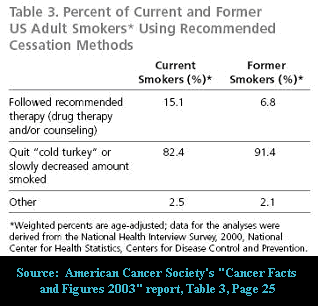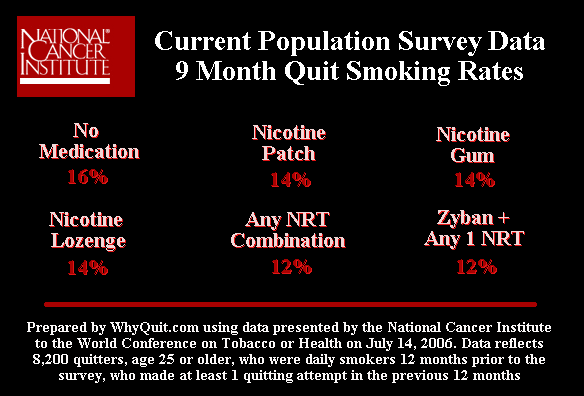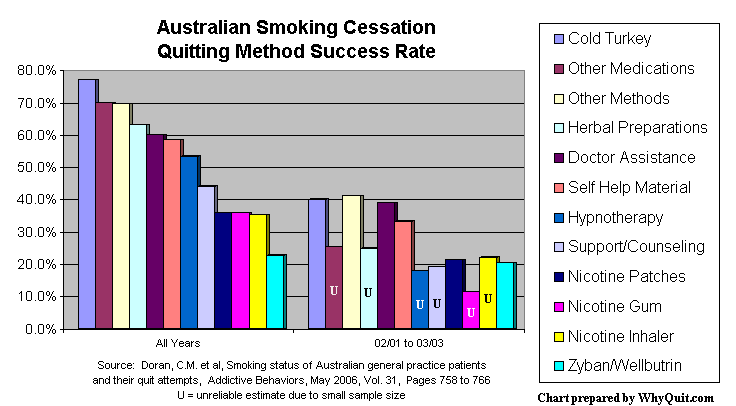Great American Smokeout Hijacked
When the American Cancer Society (ACS) held the first Smokeout in 1976 it was to make smokers aware of the importance of quitting, to provide a firm date for getting started, and to share literature on how to succeed. Sadly, thirty Smokouts later it has been transformed from a national day to stop using nicotine, into a day to try a different nicotine delivery vehicle, or nicotine designer drug, and replace it.
Held the third Thursday in November, just prior to and during the Great American Smokeout (GASO), U.S. smokers are bombarded with nicotine replacement therapy (NRT), Chantix (varenicline), and e-cigarette ads and commercials.
NRT ads will likely again falsely imply that NRT products are highly effective in real-world use, twice as effective as quitting cold turkey, and that it's nearly impossible to quit nicotine abruptly.
If nearly impossible, why is the CDC reporting that there are more ex-smokers (45.7 million) than smokers (45.3 million) in the U.S., and the Chairman of the panel that authored the U.S. quit smoking Guideline (Fiore) asserting that "about 90 percent of people who give up smoking do so on their own"?
Pfizer's new Chantix commercials will continue to pull a rabbit out of a hat and then try to convince smokers it's really a turkey, a cold turkey who starts fast but always loses to turtles. A truthful ad would teach smokers that the turtle has not yet competed against real cold turkey quitters (who fully expect to endure and navigate withdrawal) but instead defeated quitters who wanted 12 weeks of free Chantix pills but were instead punished by assignment to the placebo group where they were thrown into full blown nicotine withdrawal, had their expectations frustrated, and nearly 80% relapsed to smoking within the first two weeks.
In 1996, the ACS announced partnering with SmithKline Beecham (now GlaxoSmithKline), the major U.S. NRT seller. The ACS assured the world, while accepting SmithKline Beechman's generous financial donations ($1 million per year), that its new affiliation was toward "efforts to expand its education of products and methods relevant to smoking cessation." But a visit to the American Cancer Society's online"Guide to Quitting Smoking" reveals just how far education expansion has come.
Today, visitors to the ACS site will find 235 lines of type devoted to what it terms "medicine" (nicotine replacement products, Zyban and Chantix), while cold turkey, the quitting method today being used by the vast majority of quitters, and the method that has never once given the ACS so much as one thin dime, is never mentioned.
Instead of encouraging smokers to trust in, educate and support their natural instinct to end all nicotine use, the ACS tells them that their natural instincts are all wrong. Its Guide declares that "For most people, the best way to quit will be some combination of medicine, a method to change personal habits, and emotional support. " But is it true?
Not according to Joel Spitzer, a thirty year Chicago quitting programs director and director of education at WhyQuit, the Internet's oldest and most popular cold turkey quitting forum. "Contrary to the bill of goods being sold to smokers, most quitters are still quitting cold turkey and more importantly the vast majority of successful quitters also quit by going cold turkey," says Spitzer.
 Surprisingly, the Society's own research supports Spitzer's contentions. Surrounded by almost mandatory NRT use recommendations, page 25 of the American Cancer Society's Cancer Facts & Figures 2003 report contains a table indicating that 81% of current quitters and 91.2% of former successful quitters quit entirely on their own without any resort to quitting aids.
Surprisingly, the Society's own research supports Spitzer's contentions. Surrounded by almost mandatory NRT use recommendations, page 25 of the American Cancer Society's Cancer Facts & Figures 2003 report contains a table indicating that 81% of current quitters and 91.2% of former successful quitters quit entirely on their own without any resort to quitting aids.
"Save your hard earned money," says Spitzer, "quitting should cost you nothing." "People should do their own surveys. They should talk to their own family members and friends who have successfully been off all nicotine for at least a year. They should ask these people how they did it."
If 91.2% of successful quitters did not use the nicotine patch, gum, lozenge, inhaler, hypnosis, acupuncture, Zyban, Wellbutrin, Smoke-Away, magic herbs or any formal quitting program, what are their secrets, why are they not being shared and why the need to constantly undermine the world's most productive means of quitting?
"Most people succeed by coming to grips with the idea that to stay smoke-free they cannot take a puff on a cigarette," says Spitzer. "Try to find one person, who once had quit but are now smokers again, who didn't take a puff. Finding one such person is going to take you the rest of your life."

The ACS assertion that for most people the best way to quit includes use of "medicine" is also not supported by independent quitting method surveys. Not only is cold turkey by far America's most productive quitting method, a recent government survey suggests that it may be the most effective.
In 2006, a National Cancer Institute (NCI) study analyzed Tobacco Use Supplement data from the U.S. Current Population Survey. It found that 16% of those quitting without the aid of any pharmaceutical quitting product were still not smoking at nine months. It also found that only 14% of nicotine patch quitters, 14% of nicotine gum and lozenge users, 14% of Zyban users, and 12% of users who combined Zyban with NRT were still not smoking.

The NCI survey is backed by a study published in May 2006 that analyzed 2002 and 2003 patient quitting method data collected by 1,000 Australian family practice physicians. Patients were asked their smoking status, how long since they had last smoked and which of twelve quitting methods they used during their last attempt.
The study established success rates for each of twelve methods by "dividing the total number of successful patients (former smokers) by total number of patients attempting to quit (former plus current) using that method." In analyzing former smokers, it looked at the quitting method used by each former smoker during their last attempt, regardless of the year in which they quit. In assessing current smokers it looked at their last unsuccessful attempt, so long as it occurred within the prior five years. As shown below, the analysis produced rather high success rates.
Success rates among 2,207 former smokers and 928 current smokers were: cold turkey 77.2% (1,942 former, 575 current); nicotine patch 35.9% (145 former, 259 current); nicotine gum 35.9% (52 former, 93 current); nicotine inhaler 35.3% (12 former, 22 current); and bupropion (Zyban or Wellbutrin) 22.8% (36 former, 122 current).

Not only was cold turkey quitting the most effective method -- doubling the rate of pharmacology quitters -- it was by far the most productive method. Successful cold turkey quitters accounted for 1,942 of 2,207 former smokers, a whopping 88% of all success stories.
In theory, all quitting methods should do at least as well as cold turkey. If not, the method has somehow managed to undermine the quitter's own natural ability to break free from nicotine's grip. The Australian study shows that NRT and bupropion clearly undercut a quitter's odds. Other methods surveyed actually came closer to keeping pace with abrupt nicotine cessation.
Confused yet? It only gets worse. To its credit, the ACS quitting medicine page does warn those contemplating using NRT that they face the risk of becoming chronically dependent upon it ("However, the FDA warns users that since this product contains nicotine, it can be addictive" and "Long-term dependence is one possible disadvantage of nicotine gum. In fact, research has shown that 15% to 20% of gum users who successfully quit smoking continue using the gum for a year or longer").
But among the "medication" issues the ACS fails to mention are: (1) that six-month quit smoking rates for second time nicotine patch users are near 0%, (2) that six-month over-the-counter nicotine gum and patch quitting rates were found to be just 7%, (3) that it may be impossible to use placebo control groups in drug addiction clinical studies, as those addicted to nicotine can tell the difference between getting a free nicotine fix and being punished by assignment to an inert placebo and being intentionally thrown into full blown nicotine withdrawal, and (4) aside from the seven common Chantix side effects listed by the ACS, that the Chantix full prescribing information sheet lists 158 additional possible side-effects including: "Rare: Bradyphrenia, Euphoric mood, Hallucination, Psychotic disorder, Suicidal ideation."
One of the saddest consequences of putting corporate donations ahead of successful cessation might be evidenced by the American Cancer Society's once heralded "Fresh Start" quit smoking programs. Prior to their transformation into nicotine replacement programs, they were primarily abrupt nicotine cessation education, coping skills development and support programs, and home to America's cold turkey quitters. Objective studies found that they produced one-year quitting rates of 23-24%. That's three times higher than the over-the-counter NRT's dismal 7% six-month rate (link to full text copy of OTC NRT study), and higher than Chantix.
Do not grow discouraged should the ACS's medication advice totally fail you, as it has millions of other Americans facing a very real prospect of developing smoking related cancers. Instead, consider listening to the old American Cancer Society, the one we all once trusted, and returning to the Smokeout's 1976 roots -- a day to quit, actually quitting for a day, and reading some solid nicotine dependency recovery information.
Read WhyQuit's eight pages of abrupt nicotine cessation tips and then ask yourself why the ACS turns its back on the education needs of the more than 13 million Americans, each year, who attempt to quit smoking cold turkey. Until the ACS sees its own credibility as more important and valuable than pharmaceutical contributions, it will continue to tell them that their natural instincts are all wrong.
About the Author: John R. Polito is a South Carolina nicotine cessation educator and the 1999 founder of WhyQuit, a free online cessation motivation, education and peer support forum. John is solely responsible for the content of this article. Any factual error will be immediately corrected upon forwarding of evidence of the error to john@whyquit.com.
November 2007 Great American Smokeout Addendum
- Nicotine Fix - Behind Antismoking Policy, Influence of Drug Industry - Wall Street Journal Pulitzer Prize winning journalist Kevin Helliker writes a February 8, 2007 front page article which effectively questions the truthfulness of the American Cancer Society's Great American Smokeout advice that "for most people, the best way to quit" will involve "medicine."
- "Will Chantix really help me quit smoking?" - This August 2007 article reviews Pfizer's Chantix (varenicline) studies.
- Flawed research equates placebo to cold turkey - This March 2007 article questions the truthfulness of the pharmaceutical industry's repeated marketing suggestion that NRT has prevailed in direct competition with "real" cold turkey quitters.
- Nixing the Patch: Smokers quit cold turkey - by Ken Millstone, February 2007
- Nicotine for the Fetus, the Infant and Adolescent - H.K. Ginzel, MD, February 2007
November 2006 GASO Addendum
- Watch video quit smoking lessons during Smokeout - Imagine spending the Thursday November 16, 2006 Great American Smokeout with one of the world's leading quit smoking counselors, Joel Spitzer of Chicago. Imagine inviting him into your home via nearly 40 video quit smoking lessons.
- Is the U.S. Government's Quitting Policy Killing Smokers? - The June 2000 U.S. policy requiring that nicotine replacement products (patch, gum, lozenge, spray, inhaler) and/or bupropion (Zyban or Wellbutrin) be used with all patients attempting smoking cessation effectively disowned and outlawed the quitting method that the CDC openly admits has been responsible for 90% of all successful long-term U.S. quitters - cold turkey quitting. Although these products promised to double quitting rates the CDC reports that for the first time since 1997 quitting rates have stalled.
- Both Chantix (U.S.) and Champix (Europe) were approved for prescription use during 2006. Another nicotine imitator,the active chemical, varenicline, generates elevated dopamine levels equivalent to 30% to 60% of what nicotine generates.
November 2005 GASO Addendum
- Smokeout Cold Turkey Quit Smoking Tips - a collection of 100 cold turkey quitting tips
- The 29th Great American Smokeout, Thursday, November 17, 2005 - More than 40 million Americans have successfully quit smoking cold turkey. Contrary to it being rare for cold turkey quitters to succeed, a far more accurate and honest quitting methods representation to make during the 29th Great American Smokeout would be that cold turkey it is the cessation method used by almost all successful quitters.
- Do you know how to quit smoking? Test your smoking cessation IQ It is amazing how few smokers have ever taken the time to read the instructions that came with their addiction.
November 2004 GASO Addendum
There have been a number of NRT developments since last year's Great American Smokeout and WhyQuit has added a few new articles relevant to this 2003 release. Readers are directed to the following:
- "40 Years of Progress? - A short article in which Joel shares a common example of media "group think" in which reporters continue to ignore simple truths as they buy into the fiction that when sold by pharmaceutical companies the natural insecticide and teratogen nicotine magically becomes "medicine" and its use "therapy."
- NRT studies were not blind as claimed - A June 2004 study asserts that 71% of NRT studies assessing blindness failed their own assessment. In that many studies were funded by the pharmaceutical industry and producing a positive assessment should be relatively easy (conduct the survey as late as possible after memories fade or only interview successful participants who would likely attribute their quitting to the placebo or active device), science should now be asking itself if it is impossible to use placebo devices when the chemical being tested is psychoactive and produces an adrenaline/dopamine high, as does nicotine.
- Canadian Quitters disprove NRT's "double your chances" assertion - In relation to formal NRT studies, quitter surveys are relatively inexpensive, quick, and easy to perform yet we have not yet seen ANY "real-world" quitter survey from ANY portion of the globe where a greater percentage of those using NRT products succeeded in breaking free from nicotine than those quitting entirely on their own. We now add the "2000 Quebec Quit and Win" survey to a growing list that should have all credible researchers asking why surveys are not more accurate than double-blind studies that were not blind.
- A Quitter's Dilemma: Hooked on the Cure - A New York Times article gives wide exposure to a November 2003 GSK study admission that 36.6% of gum users may be hooked on nicotine gum. WhyQuit's education director, Joel Spitzer, is quoted in the story and finds himself twice appearing on national television news shows (Fox News & CNBC) educating viewers as to the true merits of what is by far the world's most productive method of quitting - abrupt nicotine cessation.



